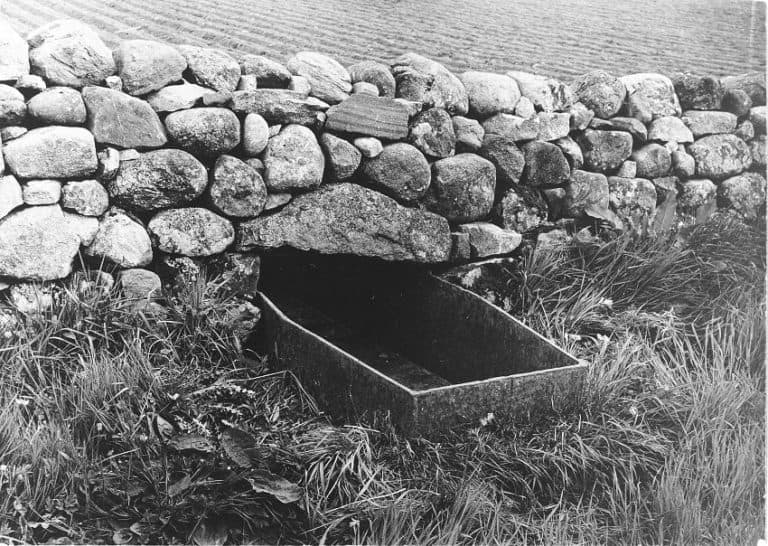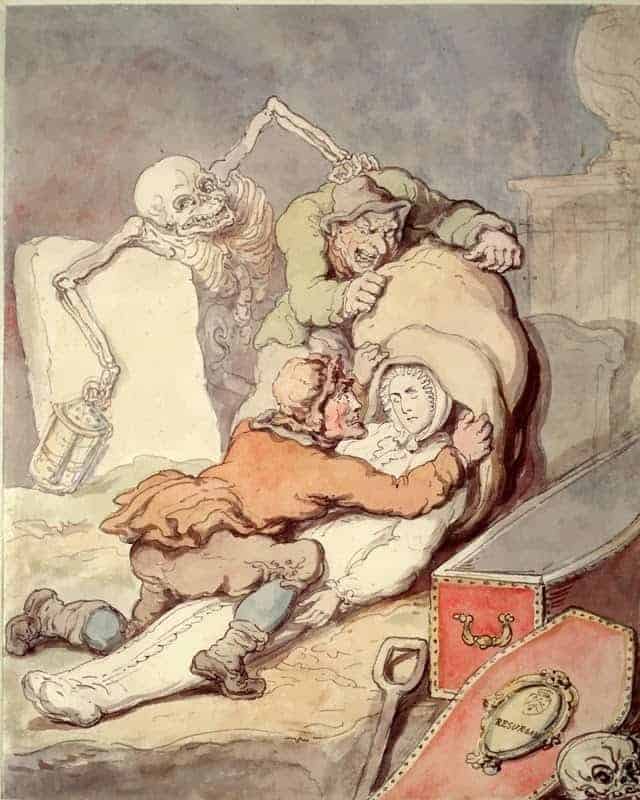Half Hangit Maggie: The Woman Who Came Back To Life
The legend of Half Hangit Maggie, is one of the most re-told tales on Edinburgh’s Grassmarket and a story that is universally known as being about the woman who survived a date with the hangman.
I’ve come across Maggie’s story many times as I’ve been researching different aspects of body snatching and it’s perhaps only now that I’ve finally thought about taking a moment to look at her case in more detail.

But what is her story and who on earth was Half Hangit Maggie, real name Margaret Dickson, anyway?
There are a number of accounts relating to the hanging of Margaret or Maggie Dickson, but as a whole, most agree that Maggie was tried for concealing the birth of her infant son and was hanged in Edinburgh’s Grassmarket, 2 September 1724. Coming back to life in the back of a cart on her way to be buried in Musselburgh, Half Hangit Maggie would live on for a further 30 or 40 years, dying it’s believed, in 1765.
In this post, I’ve looked at all the evidence that’s out there, without having to dive into the archives and write an academic essay, and pieced together Maggie’s story one more time.
Table of Contents
- Who Was Margaret Or Maggie Dickson?
- Where Was Half Hangit Maggie From?
- What Had Maggie Done?
- The Trial of Half Hangit Maggie
- Why Is Maggie Dickson Called Half Hangit Maggie ?
- A Scuffle At Edinburgh’s Grassmarket
- How Did Maggie Dickson Survive Being Hanged?
- The Journey Home
- What Happened To Half Hangit Maggie After She Recovered?
- Taking Things Further
Who Was Margaret Or Maggie Dickson?
The best place to start is right at the beginning with the woman herself and although I knew a little about Margaret Dickson, I knew I could definitely do with a little refresher.
Margaret Dickson was born in Musselburgh, five miles from Edinburgh in around 1702. Here she lived with her husband until he deserted her in 1723. Best known for cheating the gallows in Edinburgh’s Grassmarket, Margaret would go on to live a full and happy life for another 40 years after making a full recovery.
Margaret had been married to a Patrick Spence* who by all accounts was a fisherman since Margaret is affectionately referred to as a former fish-wife in most accounts.
The disappearance of her husband is shrouded in mystery, some say he was press-ganged into the Royal Navy, others that he was lured onboard a fishing fleet out of Newcastle in 1723 and never seen again, as hinted at in the Musselburgh News of 1890.
But no one seems to know for certain.
Either way, Maggie was left on her own and needed to find a way of supporting herself, no longer being able to rely on her husband as a bolster.
Where Was Half Hangit Maggie From?
Where Half Hangit Maggie lived is open to debate and there are two towns on the outskirts of Edinburgh that lay claim to being Margaret’s home; Inveresk and Musselburgh, both of which lie within about a mile of each other.
It doesn’t help that these two locations lie only minutes from each other and are probably used interchangeably because of this. Either that, or Maggie lived in the middle of the two and no-one knew where the parish boundary was!
Inveresk
The first, and less well-referenced location for Maggie’s hometown is Inveresk, being some six miles from Edinburgh. In 1724, the year of Maggie’s near-death experience, when a plough man’s weekly wage was 5/-’ [1] Inveresk was a parish excelling at growing timber and for a parish a little inland from the coast, I would have thought Maggie’s ‘fish-husband’ would have worked in the timber trade rather than on the sea.
Musselburgh
As it stands, Musselburgh seems to be the firm favourite as the location where, in around 1702, Margaret Dickson is said to have been born.
Lying about five miles outside of Edinburgh, and less than one mile from Inveresk, Musselburgh is much nearer to the coast and it is the definite forerunner as Maggie’s home town, especially if you take into account her husband’s occupation.
Eighteenth-century Musselburgh had a thriving economy, not only due to the woollen mills and coal mines, but also in part to an up and coming fishing industry, which boasted its very own harbour at Fisherrow [2]
Musselburgh and Inveresk shared the same parish church, dedicated to St Michael. The church you see today however is not the church that Margaret would have worshipped in. Her parish church was a much smaller affair and was replaced by the current church in 1806 due to a growing population.
It would, however, have been the final resting place for Maggie had this legendary figure not come back to life in the back of a cart a few hours after her botched execution.
By the time Margaret’s husband had wandered off in 1723, the population of Musselburgh was probably hovering under 4500 – it was at 4645 in 1755 – and it was about to lose another of its population in only a few short months time.
What Had Maggie Done?
By 1723, Margaret Dickson felt that it was time to leave Musselburgh and create her own life without her husband.
A lonely soul, history shows Margaret wandering through the streets of Edinburgh selling salt – the same occupation as Burke and Hare’s 3rd victim Abigail Simpson would do some 100 years later – or making her way to the town of Kelso in the Scottish borders.
Wherever she ended up – and I personally favour Kelso here – Maggie soon found herself working in an Inn, and becoming closer and closer to the landlord’s son.
Within the space of twelve months, Margaret had given birth to a baby boy.
So what was Half Hangit Maggie’s crime?
As a whole, accounts seem to agree that Maggie Dickson, aged 23 and formerly of Musselburgh concealed the birth of her infant son. There is some doubt as to whether her son was born alive or died some days later, but Margaret kept quiet about the birth, worried that she’d lose her position at the Inn.
Anxious as to what steps to take next, Maggie tried to conceal the birth, and subsequent death of her child by carefully wrapping up his lifeless body and placing him on the banks of the River Tweed.
When the body was discovered a few days later, washed up on a river bank further downstream at Maxwellheugh, everything was pointing back to Margaret, suggesting that she’d concealed the birth of her now dead infant.
Swiftly arrested, Maggie was taken back to Edinburgh and placed in either Edinburgh Gaol or the Tollbooth to await her trial.
The Trial of Half Hangit Maggie
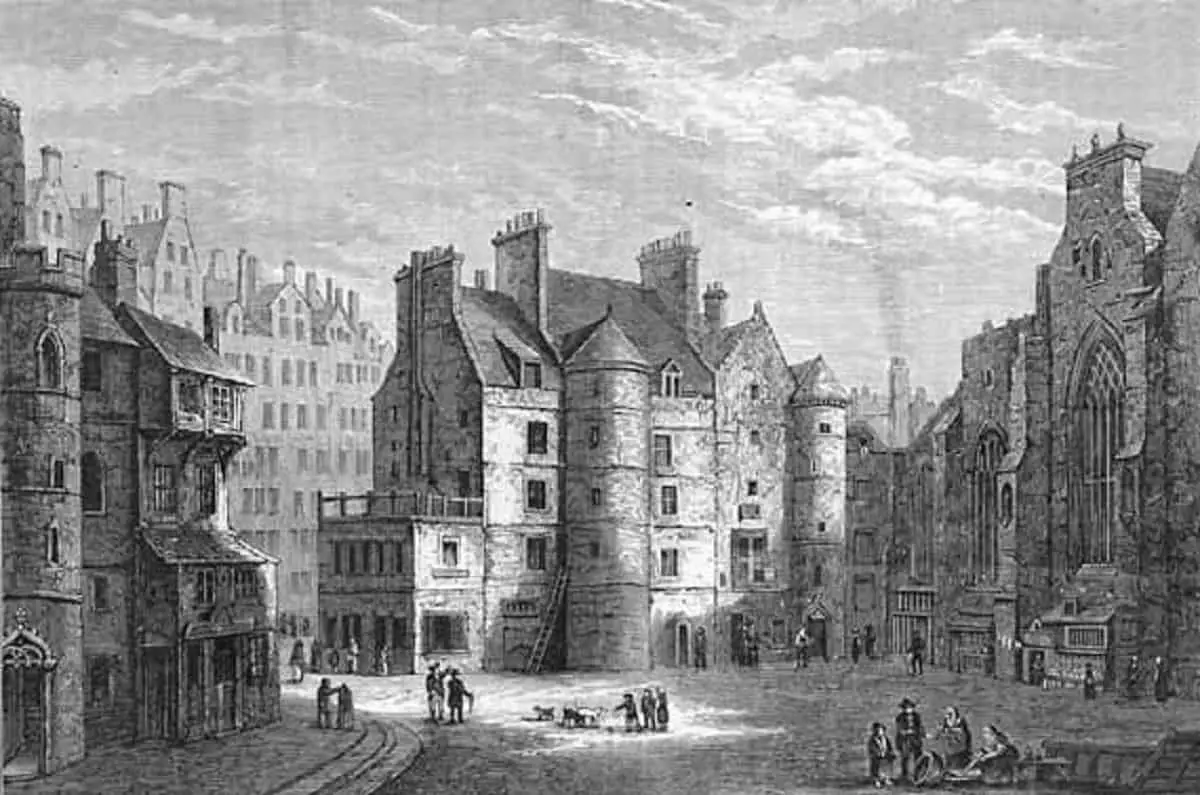
The trial of Margaret Dickson took place in Edinburgh and it is thought that she was tried under the Concealment of Pregnancy Act, although this is not known for certain.
An inquest was carried out on her son’s body to try to determine whether or not he’d been born alive. The surgeon involved made the usual experiments, trying to see if the child’s lungs had drawn breath before they’d reached the water.
The surgeon deposed, that when the lungs of the child were put into water they swimmed, so that it was their opinion that it had breathed ; for as they said, unless a child has breathed, so as air could be drawn into the lungs those parts of the body will not swim [3]
Despite this test being unreliable, and despite Maggie protesting her innocence, the jury found her guilty and on August 6, sentenced her to death the following month.
Why Is Maggie Dickson Called Half Hangit Maggie ?
Maggie’s unusual nickname comes from her remarkable recovery after being ‘half hanged’ on the gallows in Edinburgh’s Grassmarket on 2 September 1724. After being jostled back to life in the back of a cart on her way to Musselburgh.
At the gallows on that September day, a few things are said to have occurred which could have possibly led to the failed hanging of Maggie Dickson.
Before we go any further however, a quick word about the dates of the event itself. There are numerous suggestions out there, some missing the mark by only a few days, others by a few years.
The most outlandish suggestion I have seen, apart from the account in ‘The Particulars of the Life, Trial, Character and Behaviour of Margaret Dickson’ mentioned below, is that the trial took place in 1791, almost thirty years AFTER Margaret’s supposed death (the second one).
One of the main factors in her survival was perhaps to do with a conversation between Maggie and the hangman himself, Jock Dalgleish.
Legend has it that the Jock tied the noose just that little bit looser around Maggie’s neck that day, just enough for her to get her fingers through and to stop it tightening around her throat.
Whether the conversation took place in Maggie’s cell before her execution, or at the top of the ladder at which Maggie stood before she was pushed off is debatable – as is that fact whether a conversation ever happened at all.
And so it was, with Maggie standing on a bucket – or a ladder, it depends which version you read – with a noose around her neck, the hangman gave one quick shove and Maggie was launched into eternity. Well nearly.
A Scuffle At Edinburgh’s Grassmarket
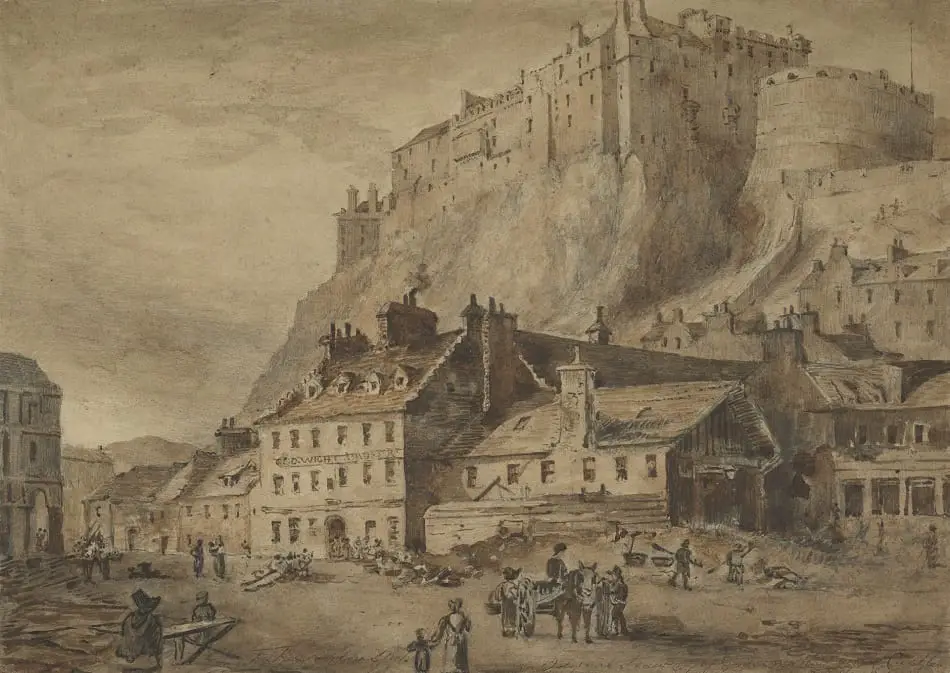
What happened next was a scene all too familiar at the gallows in Eighteenth century Scotland.
A rush of medical students, friends and family made a beeline for Margaret’s hanging body and all started to pull and tug at her legs.
The reason for this was twofold, first to hasten death. Early hanging techniques were notorious for strangling the accused rather than snapping the neck and so ‘pulling your leg’ not only hasten death, but also gave us the origin of the phrase we use today. The phrase ‘kick the bucket’ can also trace its origins back to the gallows.
The second more sinister reason was to lay claim to Margaret’s body.
With the legal supply of cadavers being in extremely short supply for Edinburgh’s medical students, tussles at the gallows were commonplace between medical students and family/ friends of the deceased.
Students wanted to lay claim to a cadaver that they thought was legally available to them, while relatives were anxious to give the accused a Christian burial.
When Half Hangit Maggie was swinging on the end of a rope, it was just at the beginning of the body snatching craze in Scotland, medical students were terrorising graveyards to secure a cadaver for the dissecting table and there wasn’t really much that got in their way.
How Did Maggie Dickson Survive Being Hanged?
With Maggie’s friends winning over the medical students, they quickly tucked her into a wooden coffin and placed her on the back of a bier to take her the five miles back to Musselburgh and her Christian burial.
Once Margaret had vacated the scene, a soldier in the Kirk’s Regiment spotted that the hangman had left a short length of rope attached – actually it was the halter itself – to the gallows [4]
In an era when anything obtained from a hanging – be it rope, clothing or other souvenirs from the accused – was considered lucky, the soldier spotted his chance.
Quicker than you like, he’d scaled the ladders still leaning against the gallows and then, according to The Scots Magazine he:
Seized the rope, and fell and un-noosing it with his teeth; which his serjeant perceiving, fell upon him with his cane, and severely drubbed [beat] bim for his pains
The Journey Home
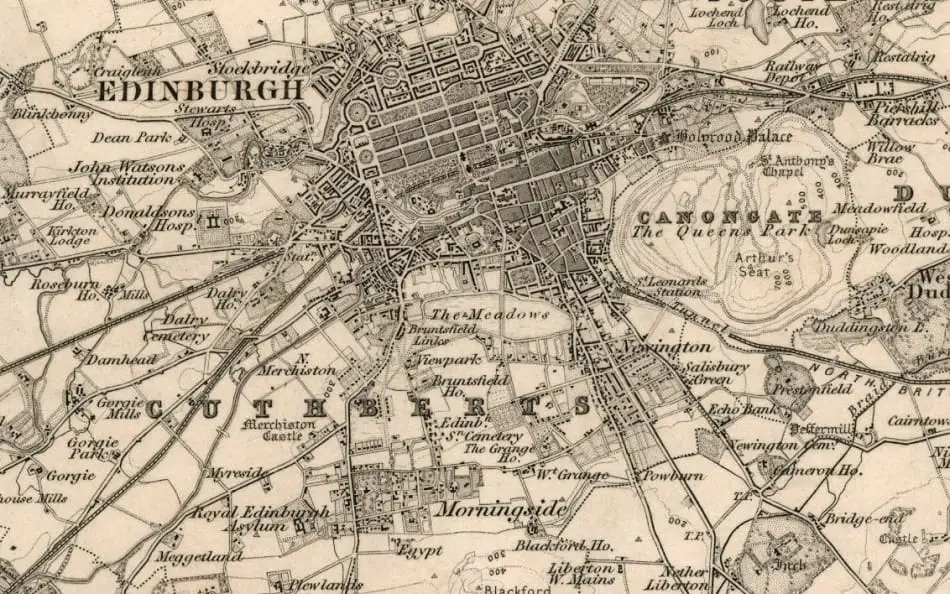
The route home took the party through Peffermill, on the outskirts of Edinburgh – past modern-day Newington and to the east of Morningside, and it is here that events took a completely unexpected turn.
Having survived a hanging by hangman Jock Galgleish, Margaret Dickson was jostled back to life whilst in a coffin on the back of a cart on her way to be buried in Musselburgh graveyard.
The group of friends who’d rescued Maggie from the clutches of the students had paused for refreshments along the route, leaving Maggie outside in her coffin. Due to the risk of her cadaver being snatched by some cunning medical students, I have no problem in saying that there would have been someone keeping guarding over her coffin, hoping that an ale or two would have been heading in their direction.
Accounts say differently, however. According to legend, Maggie was placed in front of a window so she could be guarded from within the pub – but accounts of the story seem so blurred, that either event could be true.
Fortunately, one of the party saw the coffin lid move as he happened to glance in that direction, a soft moaning could be heard coming from inside. A gardener working nearby heard it too and rushed over and removed the coffin lid, giving Margaret some much needed air.
It is thought the jostling of the cart had literally shook Maggie back to life, an act of God that would eventually give Maggie her freedom.
A full examination by a local surgeon did indeed reveal that Maggie had made a full recovery. A lucky escape some may say and in less than an hour this remarkable woman, who had just cheated death, was allowed to walk – yes, you did read that right- back home to Musselburgh.
What Happened To Half Hangit Maggie After She Recovered?

Maggie’s story only gets better and her near brush with death seems to be the making of her.
Having arrived on foot back in her hometown of Musselburgh, her husband, the one who absconded and started Maggie’s troubles in the first place, is said to have come home and rekindled his love for her.
How true this part of the story is, is unknown, but what we can be certain of (ish) is that there was someone who fell in love with Margaret Dickson, for it is said that she went on to have a number of children.
Her experience of working in an ale house had not put her off and Maggie is recorded in the annals of history as being an ale house keeper – in a town of your choice.
Her name does live on, however, not only in the history books but also in bricks and mortar, opposite the very site where Maggie nearly met her end.
The Maggie Dickson pub, located in Edinburgh’s Grassmarket displays a plaque with Maggie’s story written up outside for all to see. I think she’d be extremely delighted to know that her name now lives on in the heart of Edinburgh City and that her story has made her an internet sensation and a tour guide’s dream.
Taking Things Further
* I recently found out about one book that’s been written by Alison Butler ‘The Hanging of Margaret Dickson’ I’ll be honest, I’ve not read it (yet) so not sure what it’s like but, but a podcast I found by Unearthed Podcast has a great interview with the author and other crime historians, and it sounds pretty good if I’m honest.
The author mentions the name of Maggie’s husband in the podcast, and I have included it here in my post. You can find a copy here on Amazon.co.uk Alternatively, there are resources out there that can help you add to the information that is available online if you prefer to do your own digging.
[1] I found an excellent FREE resource online via forgottenbooks.com called ‘Inveresk Parish Lore from Pagan Times’ where you can piece together snippets from this Scottish parish. Interesting as well if you’re doing family or local history and you want to take things further.
There are over 1 million books available to read online for FREE via this resource, so I’m sure there’ll be something of interest here.
[2] There are quite a few sites telling the history of Musselburgh but I found UndiscoveredScotland.co.uk to be one of the most readable. You can find further information on Musselburgh, and many other parishes throughout Scotland here
[3] This account of the trial is taken from a broadside ‘The Particulars of the Life, Trial, Character and Behaviour of Margaret Dickson’, which was published in 1813 and has a few glaringly obvious errors, the main one being the date in which it states Maggie was executed. Still, it’s an excellent source to look at and you can find a digitised copy on which to feast your eyes for FREE on the National Library of Scotland website and the section ‘The Word on The Street’.
[4] The story of Half Hangit Maggie, or Margaret Dickson as she was Christened, appears frequently in newspapers whatever the date, although there are more mentions of this lady the more recent your search becomes. Access to the newspapers is via the British Newspaper Archive (£) and the account retelling the soldier’s experience at the gallows can be found in The Scots Magazine Thursday, 1 December 1808, page 25.




